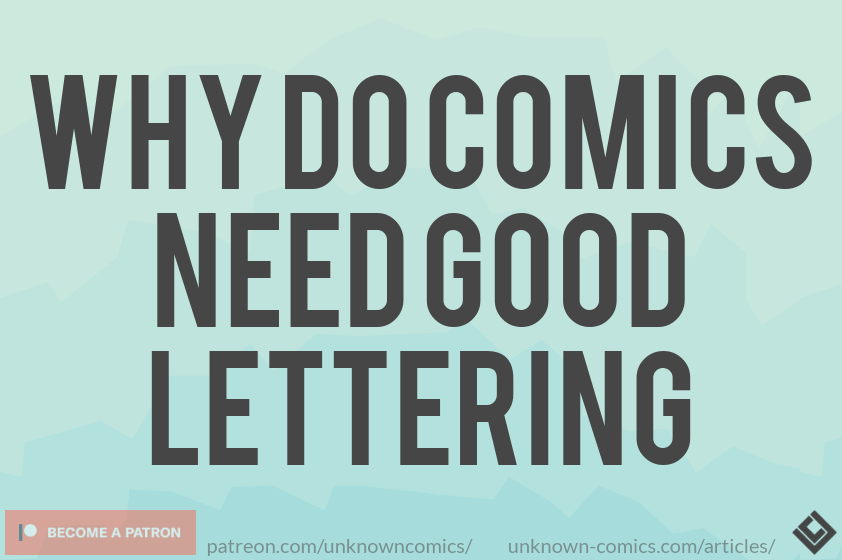Before I begin to talk about comic lettering I would like to do two things; offer a quote and an explanation as to why I have yet to talk about lettering comics after having touched on 50 other topics to date.
(If you’d like to skip this section feel free to click here to get to the actual informative section)
Why I Haven’t Talked About Lettering Yet…
The quote I’d like to pull is from one of the most notable comic letterers, Richard Starkings, one of the early pioneers of computer-based comic lettering. He once said that “a great letterer ensures that his presence is always felt but never seen, for great lettering enhances the reading experience but doesn’t stand out to distract from the art or the story.”
Now, why haven’t I touched on lettering, a crucial and delicate step in the comic creating process, up till now? There’s a couple of reasons actually. The first being that lettering is a bit of a mixture of typography, graphic design and it has its fair share of unique illustration techniques. The second reason is that I am not a visual artist. I personally struggle with wrapping my head around illustrative concepts and ideas making it difficult for me to then turn around and explain them to other people (like I am trying to do today).
Well, now we’re here and I am going to do my best to try and talk about comic lettering. So...
… Why Do Comics Need Good Lettering
Comic lettering is a tough part of the comic creating process because it’s a very delicate step. It can be incredibly easy to ruin an entire comic creating project with sub-par lettering.
Over the years I’ve come to learn that there are some key features that good lettering brings to a comic. These are dialogue, controlling the reading flow, bringing emphasis to key points in a panel or page, and assist in the ambiance brought in by the illustrations.
Just a heads up I’ll be using some terms that can be found in (the incredibly handy) comic book grammar page on Blambot. With that said I’d recommend using the page to understand some of the terms I’ll be using for this article.
Features To Look Out For In Your Lettering
Dialogue
You wrote your script. You most likely gave your characters something to think and say.
In the comic lettering world, you most likely would find all of this in thought and speech bubbles. You can get creative with your selection of the ones you’d like to use and in which order.
Like the article so far? Support the production of more articles like this one!
Reading Flow
As a comic creator controlling where your reader's eyes go is a necessary skill. You want your lettering to accentuate both your art and your desired panel-to-panel reading flow.
If not, well, your comic readers will simply get lost. Won’t know which order to read your story and leave them scratching their heads.
Emphasis
You want your lettering to bring emphasis to certain keywords and the overall tone of your characters’ way of speaking.
Everything from a well placed bolded font to the proper use of a wavy balloon can end up changing how your comic is read. Good lettering gives your characters a significant depth that you wouldn’t want your comic to miss out on.
Ambiance
This is probably one of my favorites. Good comic letterers can offer your comic a certain amount of ambiance that just illustrations alone couldn’t.
One big reason why comic lettering is necessary to accomplish this is that a comic is a still image on a page or screen. It can’t make any noises. A good example of this is illustrating someone tapping their fingers on a desk. Just drawing it doesn’t really do it justice. Maybe if you added a Tap. Tap. Tap. across a panel, you could really hammer it home what your character is doing. Depending on how to space those taps apart can even give you the impression of how slowly he is doing it.
It can really make a scene eerie.
How To Improve Your Comic Lettering
Can’t say much about this since I’m no letterer, but one good piece of advice I found over the years is this.
If You Want To Letter By Hand
Get Yourself An Arsenal
If you’re doing it all by hand (you’re a trooper if you do) you have to really learn how to do all kinds of different lettering styles. You can’t just have a comic with a single style all across. Different characters and different scenes are going to need different types of emphasis and ambiance brought to them to really make them come alive.
If You Want To Letter Digitally
Some experts would still say that you should really learn how to design new fonts by yourself, for yourself. Luckily there is another alternative to this.
You Can Always Get Your Fonts Online
There are quite a few places online that you can find that offer comic lettering fonts to use in your comics. The first place I ever found was Blambot. They have both free and paid fonts for you to browse. The following links will take you to Blambot’s pages for their Dialogue Fonts, Sound Effect Fonts, and Design Fonts. Tell Nate Pietkos (founder of Blambot) that Unknown Comics sent you. For no other reason other than I admire the guy and would like to show him that I care.
Conclusion
The conclusion of this article is pretty simple and sweet if you ask me.
Get yourself a good comic letterer, or become one.
Simply put, you either gotta practice or penny up and search and properly pay a good letterer for his valued services.
Alternatively, be willing to invest your time and energy to pay for someone to learn.
I don’t want to discount not giving someone a big break in the comic industry. Paying an inexperienced comic letterer can be more affordable but may require a lot of investment in time guiding them to provide you the type of work you’re looking to get done.
The second conclusion that I’d like to bring up is the features that good comic lettering can bring out of your comic. Everything from the dialogue, control over how your comic is scanned by the eyes of your comic readers, just what gets emphasized, to the ambiance. I’d also like to remind you that bad comic lettering can ruin each and every one of those features in your comic making it just short of worthless.
I know I didn’t really discuss it, but there is also a third conclusion I hoped this article would bring out you. Respect your comic letterers. Really, don’t disrespect them. Their job is crucial, important, and it requires a lot of passion and talent to perform.
Don’t undersell a good letterer, and try to help new talent form when you can. The comic industry deserves and needs good comic letterers.
Sign Up For
The Unknown Times!
Content Updates
Website News
Recommended Reading
And More to Come!
*Once every two weeks!*
Liked the article? Become part of my Patreon Community!
About The Author

Phillip Allen
Writer, Editor, and Founder of Unknown Comics
Hello there! My name is Phillip Allen and I'm the writer, editor, and founder of Unknown Comics. I am an aspiring comic book creator. In an attempt to learn how to create my own comic I came to learn just how few reliable resources existed out there. From a few books and unhelpful websites I decided to focus my attention on researching and writing a resource for both myself and the rest of the comic creating industry. This website and and its content is the result of all of that hard work.

